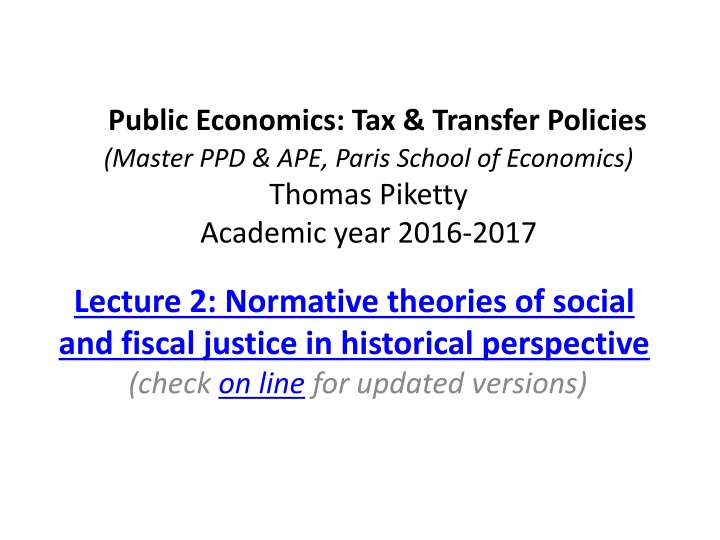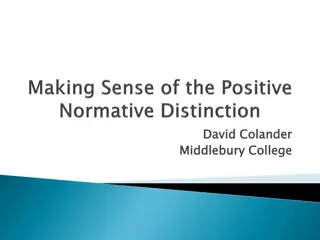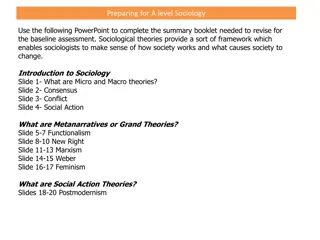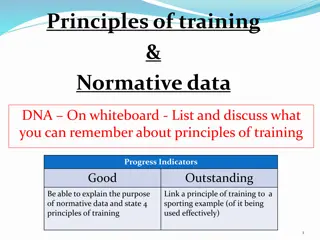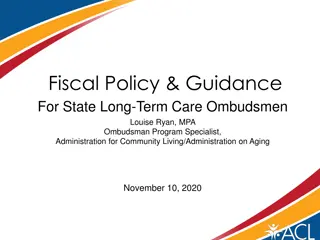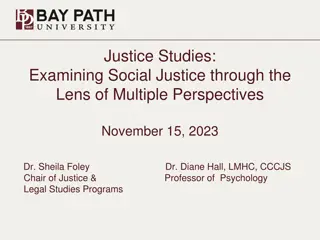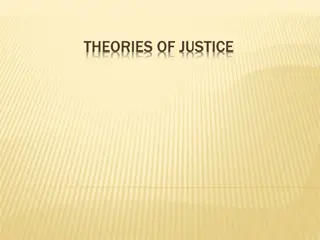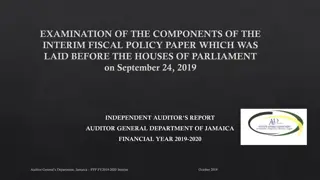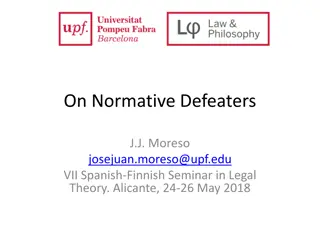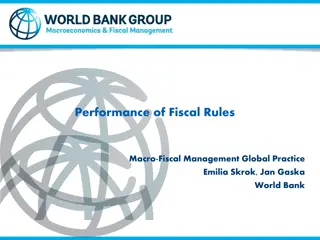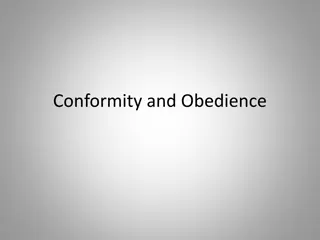Normative Theories of Social and Fiscal Justice in Historical Perspective
The lecture explores normative theories of social and fiscal justice, focusing on social objective functions, utilitarianism, maximin principle, and general social welfare functions. It discusses the challenges of determining social objectives in a world with conflicting values and beliefs, emphasizing the importance of referring to universal moral values in shaping public policies.
Download Presentation

Please find below an Image/Link to download the presentation.
The content on the website is provided AS IS for your information and personal use only. It may not be sold, licensed, or shared on other websites without obtaining consent from the author.If you encounter any issues during the download, it is possible that the publisher has removed the file from their server.
You are allowed to download the files provided on this website for personal or commercial use, subject to the condition that they are used lawfully. All files are the property of their respective owners.
The content on the website is provided AS IS for your information and personal use only. It may not be sold, licensed, or shared on other websites without obtaining consent from the author.
E N D
Presentation Transcript
Public Economics: Tax & Transfer Policies (Master PPD & APE, Paris School of Economics) Thomas Piketty Academic year 2016-2017 Lecture 2: Normative theories of social and fiscal justice in historical perspective (check on line for updated versions)
Roadmap of lecture 2 The notion of social objective function Utilitarianism, maximin, general SWF Non-welfarist social objectives Condorcet paradox & majority cycles Condorcet jury theorem & the constructive view of political institutions A simple model of inequality and beliefs
The notion of social objective function Social objective function (or social welfare function , SWF) = complete description of the set of objectives and values (together with trade-offs and priorities between these objectives and values) that the social planner maximizes in order to determine the socially optimal policy Of course in the real world there exists no benevolent social planner. Different individuals and social groups may have contradictory objectives, preferences and values (as well as different beliefs systems about how the economy is working, elasticity parameters, etc.)
But the interesting point is that individuals are not selfish, or at least do not present their most- preferred policy as determined by their self-interest: they usually refer to more universal objectives ( if you cut my taxes, in the end this is also going to be good for the poor ). Even if they are not always entirely sincere (pb of self-serving beliefs), these statements illustrate need to refer to universal moral values and objectives This in itself is interesting, and it does put constraints on political discourses and outcomes. Therefore the discussion on the social objective function and about normative theories of justice is critical if we want to understand actual policies
Utilitarianism, maximin, general SWF Utilitarian objective: W = 1 i nUi= maximize the sum of individual utilities Pb = one needs to assume that interpersonal comparisons of utility levels make sense, and that one can sum them up. Not clear at all that it makes any sense. Maximin objective: W = Min1 i nUi= maximize welfare of individuals with minimal welfare level One needs to be able to determine who has the lowest welfare level (the most disadvantaged social group). This is less challenging than summing up utilities. But still not easy.
General social welfare function: W = 1 i nV(Ui), with V(Ui) = concave transformation of individual utility If V(U) is linear (V(U)=U) back to utilitarianism If V(U) is infinitely concave back to maximin The concavity of the social welfare function V(.) determines the collective preference for redistribution, from utilitarianism to maximin (together with concavity of individual utility functions)
Exemple. U(c)=c (linear utility for consumption) V(c)=c1- /(1- ) (for all 0, 1) V(c)=log(c) (if =1) Marginal social welfare V (c)= c- (for all 0) As , V(c) becomes infinitely concave, i.e. individuals with higher consumption levels bring infinitely small marginal social welfare (as compared to individuals with lower consumption levels) stronger social preference for equality If there is no incentive cost to redistribution, then any >0 leads to full redistribution: Max 1 i nV(ci) under budget constraint 1 i nci C = Y (fixed) ci= C/n (full equality) With incentive costs (labor supply, etc.), full equality is generally not optimal; for given incentive costs, higher more redistribution
Other possible objective function: output maximization (SWF = Y = 1 i nci) (U(c)=c, =0) (GDP maximization) Output maximization is not seriously defended as a proper ethical objective by anyone: everybody seems to agree that it is better to have 100 individuals with 10 000 each rather than 99 individuals with 0 and 1 individual with 1 000 100 , in spite of the fact that total income is higher in the second case But output maximization is sometime adopted by economists so as not to deal explicitely with distributive issues: let s maximize output, and then it will be possible to distribute it so as to raise everybody s welfare, in a second stage Ok, except that the second stage often never happens It is impossible to separate production & distribution; one needs to adress distributive issues explicitely from the beginning Output maximization raises not-so-simple intertemporal issues: OK let s Maximize Y=C+S, but what is optimal saving & capital accumulation, i.e. how much should we save for the next generations? See lecture 7
Non-welfarist social objectives Ralws, A Theory of Justice, 1971. Two principles of justice: (1) Each person is to have an equal right to the most extensive basic liberty compatible with a similar liberty for others (2) Social and economic inequalities are to be arranged so that they are to be of the greatest benefit to the least- advantaged members of society ( maximin) Rawls is sometime summarized by economists by the maximin principle ( Rawlsian social welfare function ) However Rawls theory is more subtle: in his view, first principle (most extensive basic rights for all) has explicit and absolute priority over second principle (maximin) Non-welfarist approach: basic rights (opportunity sets) have value in themselves, independently from welfare or utility considerations; choice process is important in itself
The rights-based approach is most appropriate to account for the rise of the social and fiscal state. Modern redistribution is based upon a logic of access to substantial and concrete rights (access to free and compulsory education, access to free health care, etc.), not upon a logic of utilitarian or maximin monetary redistribution. Q.: Do basic rights only include formal right to own, move, speech, vote? What about rights to education, health, work, housing, culture, effective democracy ? This is where the discussion becomes interesting Rawls approach is maybe too restrictive and abstract, and not sufficiently explicit: rights involve political conflicts; they are are grounded in history and must be studied as such; at an abstract level, many declarations of rights express principles that are not too different from Rawls (e.g. 1789, article 1)
Les hommes naissent et demeurent libres et gaux en droits. Les distinctions sociales ne peuvent tre fond es que sur l utilit commune (D claration des droits de l homme et du citoyen, 1789, article 1) ( Men are born and remain free and equal in rights. Social distinctions can only be based upon common utility ) (sentence 2 can be interpreted as maximin) And yet it took a long time for effective rights to be extended (beyond formal equality) A. Sen develops a more concrete approach to rights and capabilities : Commodities and capabilities, OUP 1987; Development as Freedom, Anchor 1999; The Idea of Justice, HUP 2009; Development as Freedom: an Indian Perspective , IJIR 2006
Harsanyi (Can the Maximin Principle Serve as a Basis for Morality? A Critique of John Rawls's Theory , APSR 1975): maximin makes no sense: it could require us to sacrifice everything we have, just to improve slightly the well being of a small group of handicapped or mentally retarded or incurable individuals; utilitarianism makes more sense Interesting, but: (1) Harsanyi ignores Rawls first principle (basic rights and opportunities), in spite of the fact that his exemples involve substantial rights and opportunities (handicap, health), rather than abstract monetary redistribution (2) Harsanyi does not tell us how we can agree about a concavity parameter for utilitarian social welfare function
Condorcet paradox & majority cycles Arrow, Social Choice and Individual Values, 1951 Impossibility theorem = if we rule out interpersonal comparisons of utilities, then there is no consistent collective rule to aggregate individual preferences and take collective decisions (i.e. we need minimal agreement about common values and goods) In particular, the majority rule does not work: in general, one can find policies A,B,C such that a majority prefers A to B, B to C, and C to A Condorcet paradox 1785: with multi-dimensional political conflicts, majority cycles are pervasive ( democracy needs to be organized, constitution design is important) Arrow 1951 = negative results about political institutions = equivalent of Debreu 1959 Theory of Value An axiomatic analysis of economic equilibrum = positive results about economic institutions (two welfare theorems)
Concrete exemples of multi-dimensional political conflict: attitudes vertical redistribution dimension (public sector, taxation) vs attitudes vs foreigners/migrants See Roemer-Lee-Van der Straeten, Racism, Xenophobia, and Distribution: Multi-Issue Politics in Advanced Democracies, HUP 2007; JEEA 2006; JE 2005 : the xenophobia dimension substantially reduces the equilibrium level of vertical redistribution (size of public sector, etc.) Next step: are majority cycles possible? I.e. Hollande beats Sarkozy, who beats Le Pen, who beats Hollande. Not there yet, but not impossible. Electoral system is important. Deliberation system is even more important. See also Kuziemko-Norton-Saez-Stantcheva, How Elastic are Preferences for Redistribution? , AER 2015. Inequality dimension vs trust-in-government dimension.
Condorcet jury theorem and the constructive view of political institutions Condorcet jury theorem. Assume that everybody has the same objective function (same values and preferences), but has different beliefs and information about what policy is optimal (given these values and preferences). Further assume that we have to choose between two policies A and B, that everybody receives a signal providing information as to whether A or B is the optimal policy, and that everybody has the same probability p>0.5 to receive the right signal. Then with a large population, the probability that the majority rule leads to the right decision approaches 1. Nobody wants to be dictator, everybody prefers democracy.
With different signal qualities, more than 2 policies, etc. then one may prefer indirect democracy, etc.: constitution design matters See Condorcet 1785, Essai sur l application de l analyse la probabilit des d cisions rendues la pluralit des voix ; and Condorcet s contribution to revolutionary debates on ideal constitution Condorcet jury theorem = basic positive result about democratic institutions (aggregation of information through voting). Equivalent to Arrow- Debreu positive result about economic institutions (aggregation of information through the markets) The jury theorem and the majority-cycle paradox should be viewed as complementary: democracy can work, but it needs to be organized
If political conflict is about different beliefs and information (and not simply about conflicting interests and preferences), then different electoral & political systems allow for different aggregation of information: see Piketty The Information-Aggregation Approach to Political Institutions , EER 1999 But even if politics is about information, communication is always limited (pb of credibility with different prior beiefs): see Spector, Rational Debate Leads to One-Dimensional Conflict , QJE 2000 Politics is also about conflicting interests and self-serving beliefs. So it is important to regulate political finance, access to the media, etc. See Bonica-Rosenthal, Why Hasn t Democracy Slowed Rising Inequality , JEP 2013; T. Kuhner, Capitalism vs Democracy: Money in Politics and the Free Market Constitution, SUP 2014
A simple model of inequality and beliefs The aim of this simple model is to illustrate the discussion about values vs beliefs Two possible income levels: y0< y1 y0= low-paid job; y1= high-paid job Probability (yi=y1) = 0+ eiif parental income = y0 Probability (yi=y1) = 1+ eiif parental income = y1 With ei= effort, = index of how much individual effort matters, = 1- 0= index of how much inequality in social origins matters (better access to education, connexions to find jobs, etc.)
Redistributive taxation: c0=(1-t)y0+ty, c1=(1-t)y1+ty, With t = income tax rate, y=(1-p)y0+py1= average pre- tax income, p = pop. fraction getting high income Per capita tax revenue ty used to pay lump-sum cash transfer (or to finance equal access to education or other public services) t=0% : no redistribution; t=100%: full redistribution Individual i has utility Ui=ci-C(ei), with C(e)=e2/2a: Max (1-pi)c0+ pic1 C(ei), with pi= i+ ei FO condition: ei= a (1-t)(y1-y0) more redistribution leads to less effort how much this matters depends on relative importance of vs
Assume everybody agrees about some form of maximin objective: Max (1-p)c0+ pc1 C(e), with p = 0+ e (i.e. expected welfare of individuals with low parental income) Then one can show that optimal t* is given by: t* = H /a(y1-y0) 2 (H = pop fraction of indiv. with high-income parents) I.e. optimal tax t* if or , i.e. if parental origins more important & role of effort less important But this does not mean that everybody agrees about t* : different beliefs about and can lead to different t* politics as a conflict over beliefs See Piketty, Social Mobility & Redistributive Politics , QJE 1995
Why different beliefs? Because it is difficult to learn about and Self-serving beliefs also play a role: high-income individuals have a clear incentive to pretend that matters more than , and to try to spread their views in the media & political parties But even if all individuals have fully sincere, and start with same initial beliefs, one can show that different families will end up with different beliefs: e.g. if you put a lot of effort experience an upward mobility experience, you will tend to believe that effort works and update your beliefs accordingly This can explain why mobility experience and not only current income determines political attitudes
In the long run, high-income individuals tend to be more right-wing on average than low-income individuals (they want less redistribution), even if they are not selfish at all (in effect, right-wing dynasties believe more in effort and end up with higher average incomes, whether their beliefs are right or wrong) Other, more sophisticated ways to learn about optimal t*: study the comparative history of inequality and taxation, read econometric estimates of elasticities: see Lectures 3-4 But there will always be a lot of uncertainty about the conclusions one can draw from historical or econometric evidence, so the political conflict will continue, and democratic institutions will do what they can to aggregate these different beliefs
This simple model also illustrates the difficulties to define the proper social objective Assume =0, i.e. family origins do not matter, everybody faces the same probability + e to have high income y1> y0 With risk aversion (Ui=V(ci)-C(ei) and V(.) concave), one still wants redistributive taxation But with Ui=ci-C(ei), do we really want t*=0? If y1vs y0= long-term, lifetime inequality, then risk aversion might not be the relevant way to determine the socially desirable level of redistribution (with short-term risk, this is questionable as well: public unemployment insurance) Assume social objective = Max c0 C(e)
Max c0 C(e) = (1-t)y0+ty C(e) with e = a (1-t)(y1-y0), y=(1-p)y0+py1, p= + e Then one can show that t* = 2/3 + /3a(y1-y0) 2 (formula to be checked; please do it for next time!) This leads to much more redistribution than with expected welfare maximization Discussion about objective function matters, together with the discussion about beliefs and elasticities
